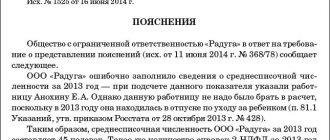Home — Articles
Some organizations, after submitting their reports, receive a message from the tax authorities (notification Appendix No. 1 to the Order of the Federal Tax Service of Russia dated May 31, 2007 N MM-3-06 / [email protected] ) with a requirement to provide explanations (Subclause 4, clause 1, Article 31, clause. 1 Article 82, paragraph 3 Article 88 of the Tax Code of the Russian Federation) on the reasons for the discrepancy between the amounts of the indicators “Income from sales” and “Non-sales income” in the income tax return (Approved by Order of the Federal Tax Service of Russia dated December 15, 2010 N ММВ-7-3 / [email protected] ) with the tax base summarized by quarter in VAT returns (Approved by Order of the Ministry of Finance of Russia dated October 15, 2009 N 104n). Should these indicators coincide and how to prepare a response to the tax authorities?
Is it necessary to explain the discrepancy between VAT and income tax?
The company received a request to provide clarifications in the form approved in Appendix No. 1 to the order of the Federal Tax Service of Russia dated 05/08/15 No. ММВ-7-2 / [email protected] The reason for sending the request was a desk audit. The fiscal authorities requested clarification on the indicators reflected in individual lines of the balance sheet (Appendix No. 1 to the order of the Ministry of Finance of Russia dated July 2, 2010 No. 66n). And they also demanded to attach documents confirming the reasons for the decrease in the “Financial Investments” indicator in the balance sheet asset.
But the Tax Code does not allow desk audits of financial statements! Controllers have the right to request documents and explanations on issues related to the calculation and payment of taxes (subclause 1, clause 1, article 31, articles 88, 93 of the Tax Code of the Russian Federation). And financial statements are necessary for users of these statements to make economic decisions (Part 1, Article 13 of Federal Law No. 402-FZ dated December 6, 2011).
In addition, the tax authorities monitor compliance with tax legislation (the regulations on the Federal Tax Service, approved by Decree of the Government of the Russian Federation dated September 30, 2004 No. 506), the Ministry of Finance of Russia is responsible for accounting reporting (Part 1 of Article 22 of the Federal Law dated December 6, 2011 No. 402-FZ, Decree Government of the Russian Federation dated June 30, 2004 No. 329). Therefore, in the request, the inspectorate may refer to a desk audit of a specific declaration and its indicators. And inspectors do not have the right to demand explanations and documents regarding financial statements. However, it is still worth responding to such a request from the inspection. A competent refusal to provide explanations will save the company from receiving a report on the discovery of facts indicating tax violations (Article 101.4 of the Tax Code of the Russian Federation), as well as from the need to further challenge this report. With my help, the organization prepared a letter refusing to comply with the inspection requirement. In response to a request for clarification, the company indicated that tax legislation does not provide for chambers in relation to accounting statements. At the same time, fiscal officials do not have the authority to control it.
Accountant PROF-Consult
It is like a principal, that is, a direct supplier. Without an explanation, the tax office may impose penalties for incorrectly provided information in the VAT return. Having figured out what the tax office expects from you, you need to compose a reasoned answer with detailed figures confirming that your organization provided the correct data.
Most often, these indicators are not equal, and there will always be an action that will lead to the formation of income that is included in the income tax, but not subject to VAT. Upon payment it is considered when the shipped goods were immediately paid for by the buyer. This is, first of all, profit that was received as a result of the sale of goods or the provision of services in-house or through intermediary services. In addition to explaining the discrepancy, your organization needs to provide a document confirming that there are no errors on your part.
There is no direct connection between “profit and VAT”
Almost every company received a requirement to provide explanations as part of a desk audit regarding VAT. Fiscal officials are often asked to explain the reasons for the discrepancies between the indicators that make up the revenue in the annual income tax return and the size of the tax bases reflected in the VAT returns for all four quarters of the reporting year. What documents are on the camera for personal income tax? It is illegal to demand >>>
In my case, the company received such a requirement as part of a desk audit of the VAT return for the fourth quarter of 2015. In addition, inspectors demanded to explain why the share of VAT deductions exceeds 89 percent. This is the permissible share of deductions used by companies to independently assess the risks of inclusion in the inspection plan (Appendix No. 2 to the order of the Federal Tax Service of Russia dated May 30, 2007 No. MM-3-06 / [email protected] hereinafter referred to as the Concept).
In the third quarter of 2015, the share of deductions was 93 percent, in the fourth quarter of 2015 - 92 percent. The desk audit was carried out for the fourth quarter of 2015 - inspectors could only demand clarification for this period. In the letter, the company reminded fiscal officials that the tax period for VAT is a quarter (Article 163 of the Tax Code of the Russian Federation). However, difficulties arose in preparing the answer. It turned out that it is difficult to explain the specific reason for the discrepancies in the declarations. The fact is that the concept of “income” for profit tax purposes (Articles 248–251 of the Tax Code of the Russian Federation) and the concept of “tax base” for VAT purposes are not identical. Consequently, revenue for the purposes of calculating income tax and the tax base for VAT purposes may be different. The company carried out both transactions subject to VAT and transactions not subject to taxation (Article 149 of the Tax Code of the Russian Federation). Discrepancies in indicators can arise not only due to these nuances, but also due to the use of completely legal optimization methods. This, in particular, issuing invoices at a later date. This method is often used at the end of the year, when the company closes large contracts. She may receive significant revenue, and the amount of VAT payable will also increase. To this amount are added advances from buyers, from which it is also necessary to calculate VAT (clause 1 of Article 167 of the Tax Code of the Russian Federation). In this case, for goods (advances) shipped (received) in the last days of the reporting year, invoices are issued at the beginning of the next year. After all, the supplier must issue an invoice to the buyer within five days from the date of shipment or receipt of an advance payment (clause 3 of Article 168 of the Tax Code of the Russian Federation). This means that it is possible to postpone the payment of VAT from January 25, 2021 to April 25, 2016 (Clause 1 of Article 174 of the Tax Code of the Russian Federation). Of course, the last thing the organization wanted to do was explain such reasons for discrepancies in the controversial declarations. Therefore, the society decided to refuse this part of the requirement. The fact is that inspectors most often require clarification in connection with errors or contradictions in declarations (clause 3 of Article 88 of the Tax Code of the Russian Federation). And the company asked the tax authorities to indicate what these errors or contradictions were. We also asked the inspectors to provide a link to the regulatory legal act, which states that revenue for the purposes of calculating income tax must be equal to the VAT tax base. In the letter, the company emphasized that Chapters 21 and 25 of the Tax Code of the Russian Federation established different procedures for the formation of these indicators.
We explain to tax authorities the reasons for the discrepancies
Typically, a tax demand is preceded by a desk audit of any declaration.
What will arouse the inspector’s suspicion and force him to send a demand:
- In the updated return, you have reduced the amount of tax (applicable to any type of tax). Of course, this may be a completely legitimate, justified action. However, when showing a tax reduction, be prepared to explain the reason and provide documents.
- The VAT return declares the tax to be reimbursed from the budget. It is not profitable for the Federal Tax Service to reimburse you, so it is quite natural that the inspector should make sure that your claim is legal. Be prepared to provide copies of all invoices.
- The safe percentage of VAT deductions has been exceeded.
- Low tax burden.
- The declaration violated the control ratios.
- The declaration shows the loss.
- The supplier did not reflect the VAT transaction.
- Counter check. When checking your counterparty, the Federal Tax Service, to ensure the legality of the transaction, requires copies of documents from both parties.
We have given the most common reasons for the requirements of the Federal Tax Service. In practice there are many more of them.
What are the VAT requirements?
After calculating data for 12 months, the company concluded that the share of deductions exceeds 89 percent. To find out what affects this indicator, we examined VAT returns in detail.
It turned out that the inspection included in the calculation the entire VAT, taking into account advances, both accrued for payment to the budget and declared for deduction. However, the Federal Tax Service of Russia believes that the share of VAT deductions should be calculated without taking into account accruals and deductions for advances (letter No. AS-4-2/12722 dated July 17, 2013). By recalculating the share of deductions, you can see how much the result will change if you take into account in the formula only the indicators of VAT accrued and presented on completed transactions and operations.
In our case, the recalculation gave an adjustment in the right direction. Without taking into account advance VAT, the share of deductions decreased by 2 percent and the deviation in the fourth quarter of 2015 was only 1 percent. Having recalculated the share of deductions due to VAT amounts from advances issued and received, the company came to the conclusion that prepayment amounts are the main reason influencing the level of the share of deductions. That is, activities related to sales in the billing period actually do not produce deviations in the share provided for by the Concept. The company sent these explanations, along with counter-calculations, to the inspectorate.
Section 5
This section is intended to reflect deductions related to activities for which a zero VAT rate can be applied, and in the past periods one of the events occurred:
- a complete package of supporting documents has been submitted;
- The 180-day period for submitting documents has expired, and the taxpayer did not have time to collect supporting documents (i.e., he lost the right to apply the zero rate).
Let's add a condition to our example:
TransExpert LLC, providing international transport services, used the services of renting a warehouse for short-term storage of transported goods in the amount of 12,480 rubles. + VAT RUB 2,496. Documents confirming the expenses incurred and an invoice for them were received only in the next quarter, i.e., after the company, following the results of the reporting quarter, had already submitted to the Federal Tax Service a package of documents confirming the right to a zero rate.
What Section 5 of the VAT return for the next quarter, completed in this case, will look like can be seen in the figure below.
What are the income tax requirements?
Income tax requirements are often no less mysterious and even more time-consuming to explain than VAT. The company received a request as part of a desk audit of the income tax return for 2015 with a request to explain the discrepancies between the expenses reflected in the statement of financial results (Appendix No. 1 to the order of the Ministry of Finance of Russia dated July 2, 2010 No. 66n) and the expenses indicated in the income tax return. income tax. The inspectors also asked the question “why the tax base for 2015 did not change compared to the tax base for 9 months of 2015, despite a significant increase in revenue amounts.”
The approach to writing explanations on such issues depends on the desire and scrupulousness of the chief accountant. If the amount of expenses in tax accounting is less than in accounting, then we can limit ourselves to a short answer that the difference was formed due to expenses that are not accepted for tax purposes. The company itself decides whether to attach documents or not. After all, the inspectorate can demand documents in a camera room only in a limited number of cases.
The company explained that the increase in expenses occurred at the end of 2015 due to the creation of a reserve for doubtful debts in tax accounting. Because of this, a difference arose between accounting and tax accounting and the tax base for income tax did not increase significantly.
rashozhdenie_v_deklaracii.jpg
Discrepancies between declarations (profit and VAT) are a common reason for receiving a notification from the Federal Tax Service requiring explanations for the discrepancies. After submitting tax reports, tax officials conduct a desk audit, one of the methods of which is cross-reconciliation of information from different documents of one enterprise. Not in all cases, receiving such claims from tax authorities is evidence of errors.






